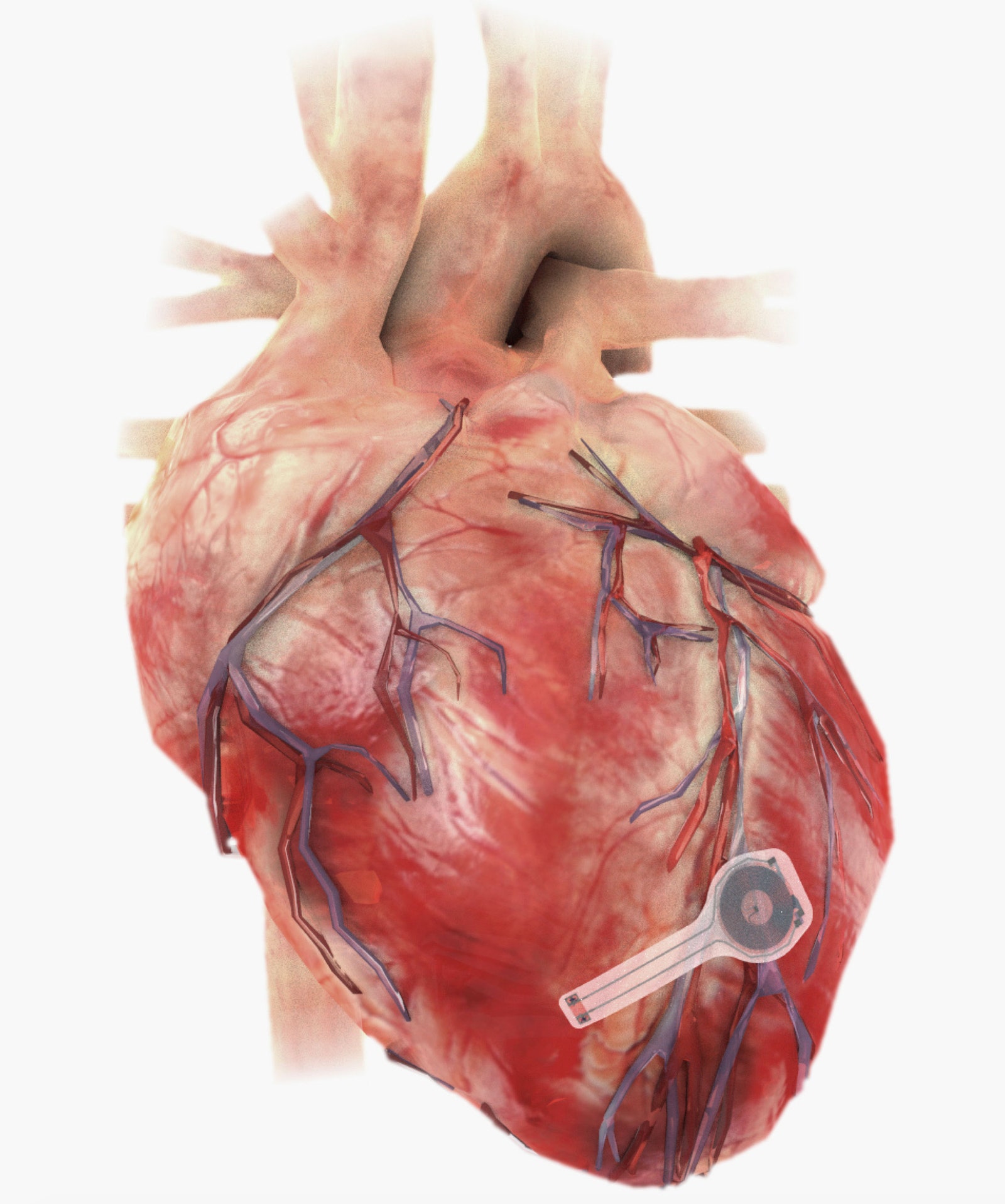The first medical implant to come of that breakthrough was a thin sheet that electrically jolts injured tissue to kick-start nerve regeneration, which the team tested in rats. Rogers then teamed up with cardiologists, including Arora, who saw an opportunity to forgo traditional temporary pacemakers used to treat slow heart rhythms. Rogers likens this dissolvable device to an internal wound healer, an “electronic medicine” in which all the components are soluble.
Illustration: Northwestern University/George Washington University
At first glance, the half-inch-wide, half-inch-long device may seem like a flimsy plastic strip. But, in actuality, it’s a dynamic stack of surfaces and carefully selected elements. The electrical contacts are a mix of tungsten and magnesium. Wireless power feeds into those contacts though a flat coiled antenna made of the same materials. Energy arrives from a near-field communication, or NFC-enabled, antenna, which could sit on a hospital bed or wearable patch. (Sorry, your phone’s tap-to-pay NFC isn’t efficient enough to unbreak any hearts yet.)
Having a stable electrical contact is critical to any cardiac device, since each blood-pumping contraction depends on heart cells firing quick impulses. But a device also has to be dynamic. When a wet heart fills and empties, its curved surface stresses and strains. The challenge of making something that is both stable and flexible has been “kind of an open question for this field for a while,” Rogers says. “Bioelectronics are great, but then how do you maintain robust interfaces over time?”
The team cracked this problem with an adhesive hydrogel, which doesn’t just stick to the heart mechanically—it latches on chemically. The hydrogel forms covalent bonds with the tissue’s surface. Loose molecular threads on the hydrogel and heart weave together chemically. Nitrogen atoms in one fuse with carbon atoms in the other, and vice versa, to form strong, protein-like connections. “It provides a mechanically soft, intimate electrical coupling,” Rogers says.
Each layer can begin dissolving as soon as it gets wet, and it’s important that the device does not degrade too soon after it’s implanted. So the pacemaker sits inside a dissolvable polymer shell that acts as a buffer against time—the hardware has two weeks to do its work while its shell dissolves. The rest starts breaking down after that, but by then, the patient shouldn’t need the pacemaker anymore. In cases where a longer-lasting device is needed, the team could build a verison with a thicker capsule.
The team tested the device on animals with small hearts (rats and mice), medium hearts (rabbits), and ones with nearly human-size hearts (dogs). In all cases, their device could control the pace of an animal’s heartbeat. (They also tested tissue isolated from human donors and found the same success.)
Rogers and Arora’s team also tested how the pacemakers faded away in rats. They showed that the devices stayed intact for one week, were mostly dissolved at three weeks, and stopped working at four weeks. By 12 weeks, they were entirely gone.
“Accomplishing that functionality, but also having the whole thing go away without having any potentially dangerous or toxic byproducts—that’s a huge challenge,” says Ellen Roche, a biomedical engineer at MIT who develops cardiac devices, who was not involved in this work. “Independently, either of those is doable,” Roche continues. “But to do them both together, I think, is a big accomplishment.”
“It’s really cool to see simple materials; we already know about their toxicity burden,” says Chris Bettinger, a biomedical engineer at Carnegie Mellon. “I think simplicity is often underappreciated.”
But an invasive device like a pacemaker will require much more testing to prove safety and efficacy in humans. Another challenge could be the landscape of the heart’s surface, which would be much more damaged among cardiac patients than among lab animals. Raman, the cardiologist who is not part of Arora’s team, notes that some of the people who might need this sort of device already have tissue scarring caused by heart disease and blockages, which would make forming electrical connections harder. “But based on the design, one would guess it’s likely to work,” Raman says.



